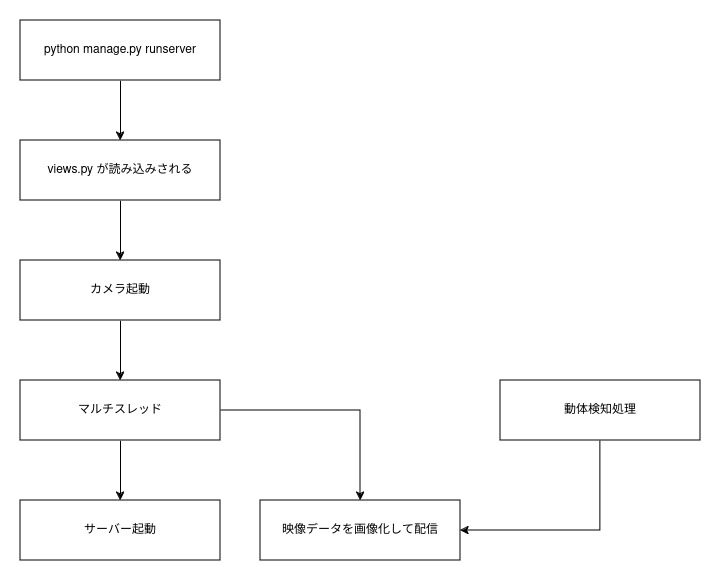【Django】OpenCVとyieldを使い、ウェブカメラの映像をライブ配信する

Djangoで、OpenCVで撮影した映像をライブ配信させる。
仕組みはyieldとマルチスレッド処理を使い、サーバー起動とライブ配信処理を並行して行っている。
撮影して画像を保存しAjaxのポーリングを繰り返すより、Django側がカメラの映像を配信し続ける本記事の方法が効率が良い。
必要なライブラリ
asgiref==3.8.1
Django==5.0.6
imutils==0.5.4
numpy==1.26.4
opencv-contrib-python==4.9.0.80
sqlparse==0.5.0
typing_extensions==4.12.0
views.py
配信処理のビューとカメラの起動を行っている。
動体検知処理の部分はコメントアウトしている(無くてもライブ配信は成立するため)
from django.shortcuts import render,redirect
from django.views import View
from .models import Topic
class IndexView(View):
def get(self, request, *args, **kwargs):
topics = Topic.objects.all()
context = { "topics":topics }
return render(request,"bbs/index.html",context)
def post(self, request, *args, **kwargs):
posted = Topic( comment = request.POST["comment"] )
posted.save()
return redirect("bbs:index")
index = IndexView.as_view()
from .detector import SingleMotionDetector
from imutils.video import VideoStream
from django.http import StreamingHttpResponse
import threading
import time
import datetime
import imutils
import cv2
# 最新のフレームが入る変数
outputFrame = None
# スレッド間でのフレームの読み書きを制御するためのロック
lock = threading.Lock()
# カメラを起動させる(このカメラの起動を任意のタイミングにすることで、使っていないときはOFFにできるのでは?)
vs = VideoStream(src=0).start()
time.sleep(2.0)
# カメラからフレームを読み取り、動体検知処理をする
def detect_motion(frameCount):
global vs, outputFrame, lock
# 動体検知処理を動かす
#md = SingleMotionDetector(accumWeight=0.1)
#total = 0
while True:
# カメラを読み込みして、リサイズする。
frame = vs.read()
frame = imutils.resize(frame, width=400)
# グレースケールとぼかしを掛ける(動体検知の高速化)
#gray = cv2.cvtColor(frame, cv2.COLOR_BGR2GRAY)
#gray = cv2.GaussianBlur(gray, (7, 7), 0)
# 現在の時刻を表示している
#timestamp = datetime.datetime.now()
#cv2.putText(frame, timestamp.strftime("%A %d %B %Y %I:%M:%S%p"), (10, frame.shape[0] - 10),cv2.FONT_HERSHEY_SIMPLEX, 0.35, (0, 0, 255), 1)
# ここで囲みをつけている
"""
if total > frameCount:
motion = md.detect(gray)
if motion is not None:
(thresh, (minX, minY, maxX, maxY)) = motion
cv2.rectangle(frame, (minX, minY), (maxX, maxY),(0, 0, 255), 2)
"""
# 動体検知機にフレームを更新する
#md.update(gray)
#total += 1
with lock:
# 最新のフレームをコピーする
outputFrame = frame.copy()
# 最新のフレームをjpgに変換して返却している
def generate():
global outputFrame, lock
while True:
with lock:
if outputFrame is None:
continue
(flag, encodedImage) = cv2.imencode(".jpg", outputFrame)
if not flag:
continue
# yield the output frame in the byte format
yield(b'--frame\r\n' b'Content-Type: image/jpeg\r\n\r\n' + bytearray(encodedImage) + b'\r\n')
# jpgデータを配信している
class StreamView(View):
def get(self, request, *args, **kwargs):
return StreamingHttpResponse(generate(), content_type="multipart/x-mixed-replace; boundary=frame")
# サーバー稼働とストリーミング配信処理を並列に実行する
t = threading.Thread(target=detect_motion, args=(32,))
t.daemon = True
t.start()
stream = StreamView.as_view()
detection.py
途中で呼び出されている、動体検知処理の部分。この部分はライブ配信には影響はしない。
# import the necessary packages
import numpy as np
import imutils
import cv2
# 動体検知処理をするクラス
class SingleMotionDetector:
def __init__(self, accumWeight=0.5):
# store the accumulated weight factor
self.accumWeight = accumWeight
# initialize the background model
self.bg = None
def update(self, image):
# if the background model is None, initialize it
if self.bg is None:
self.bg = image.copy().astype("float")
return
# update the background model by accumulating the weighted
# average
cv2.accumulateWeighted(image, self.bg, self.accumWeight)
def detect(self, image, tVal=25):
# compute the absolute difference between the background model
# and the image passed in, then threshold the delta image
delta = cv2.absdiff(self.bg.astype("uint8"), image)
thresh = cv2.threshold(delta, tVal, 255, cv2.THRESH_BINARY)[1]
# perform a series of erosions and dilations to remove small
# blobs
thresh = cv2.erode(thresh, None, iterations=2)
thresh = cv2.dilate(thresh, None, iterations=2)
# find contours in the thresholded image and initialize the
# minimum and maximum bounding box regions for motion
cnts = cv2.findContours(thresh.copy(), cv2.RETR_EXTERNAL,
cv2.CHAIN_APPROX_SIMPLE)
cnts = imutils.grab_contours(cnts)
(minX, minY) = (np.inf, np.inf)
(maxX, maxY) = (-np.inf, -np.inf)
# if no contours were found, return None
if len(cnts) == 0:
return None
# otherwise, loop over the contours
for c in cnts:
# compute the bounding box of the contour and use it to
# update the minimum and maximum bounding box regions
(x, y, w, h) = cv2.boundingRect(c)
(minX, minY) = (min(minX, x), min(minY, y))
(maxX, maxY) = (max(maxX, x + w), max(maxY, y + h))
# otherwise, return a tuple of the thresholded image along
# with bounding box
return (thresh, (minX, minY, maxX, maxY))
処理の流れ

現状の課題
動体検知処理を動かすと、CPU使用率80%を超える。(Corei5 8500にて、動体検知なしの場合は50%)
また、サイトにアクセスしていない場合でも、カメラは動き続ける。
リソースを削減するには、カメラをON、OFFにする仕組みが別途必要になる。
しかし、映像のラグはほとんどない。
ソースコード
https://github.com/seiya0723/django_livestreamer
参照元
https://pyimagesearch.com/2019/09/02/opencv-stream-video-to-web-browser-html-page/